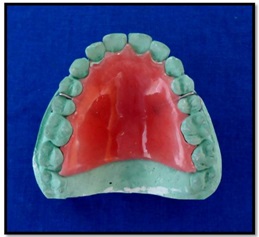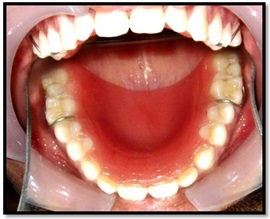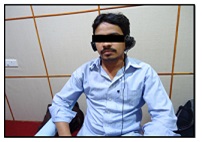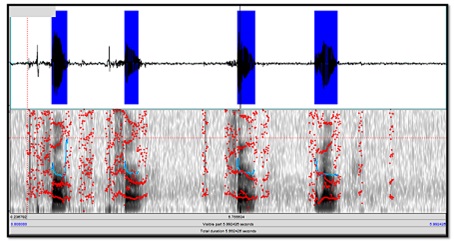Human beings are the creatures blessed by God with the unique gift of speech. Speech is defined as a dynamic production of voiced sounds for communication through the processes of Respiration, Phonation, Resonation and Articulation [1]. The dentist as a guardian of oral health is engaged to a great extent in altering structures within oral cavity to alleviate the ravages of dental problems. Speech inadequacies are frequently reported after complete or partial maxillary denture placement by most of the patients. Unduly thick denture bases cause incorrect phonation and loss of tone due to decrease in air volume and tongue room in the oral cavity. The production of sounds involves contact between the tongue, and either the palate, alveolar process or the teeth. The denture base thickness in different regions of the palate may cause incorrect formation of the sounds. The purpose of this study is to evaluate the effect of acrylic palatal plate thickness of maxillary prosthesis on Phonation.
Materials and Methods
This randomized control study was conducted in the Department of Prosthodontics, Sibar Institute of Dental Sciences, Guntur, Andhra Pradesh, India during the year 2012-2013. Twelve native speakers of Telugu between the age group of 20–25 years were selected based on the inclusion criteria. The study was conducted after obtaining the ethical clearance and written consent from each participant. The criteria for subject selection were [2]: (a) the ability of producing clear and intelligible speech, (b) adequate linguistic level, (c) normal oral structures, (d) normal hearing, (e) full complement of natural dentition. The above criteria were considered to rule out the conditions that alter the speech like tongue tie, missing teeth, faulty restorations etc. For each subject impressions were made with irreversible hydrocolloid material (Velplast Chromatic Alginate) for maxillary arch using appropriate size stainless steel stock trays. Impressions were disinfected and poured in type III dental stone, (Kalabhai Dental stone).The casts were retrieved and heat cure acrylic (DPI) experimental palatal plates (EPP) [Table/Fig-1] were fabricated in different thickness (1 mm, 2mm & 3 mm) by conventional compression molding technique. The thickness of each plate on the hard palatal area was confirmed by Iwanson caliper gauge [3]. The EPP’s were then checked intraorally for adequacy [Table/Fig-2] and necessary corrections were done and later they were disinfected and stored in diluted mouthwash till the day of test for phonation.
Experimental Palatal Plates (EPP),

Intraoral view of the experimental palatal plate

The speech material for phonation test consisted of Vowels sounds /a/, /i/, and /o/. The speech of the selected subjects was evaluated in the following experimental conditions:
Without any Experimental palatal plate (EPP)
With the 1 mm thickness EPP
With the 2 mm thickness EPP
With the 3 mm thickness EPP
Each subject was seated in an anechoic room and the speech recording was performed using a computer connected to a high quality dynamic microphone which was positioned at a constant distance (6 inches) from the lips [Table/Fig-3]. Each subject was asked to take a brief breath and to sustain the vowel sound for 3–4 seconds. The vowel sounds were maintained by the subjects in a steady and clear manner at a conversational level of loudness while monitoring a dB (decibel) level display. Subjects were reminded to pause between forming the sounds of each sample vowel in order to minimize the effect of the previously uttered vowel.
Speech recording procedurein anechoic room,

In addition, each subject was instructed to maintain the same vowel quality throughout the entire utterance. Before recording, an investigator demonstrated these procedures, and subjects performed practice trials until they showed a full understanding of the task. The above procedure was repeated for all the experimental conditions. Digital acoustic analysis was performed using personal computer based analysis software (PRAAT). Speech data was digitized at 44100 Hz with a 16-bit resolution, and displayed as an amplitude-by-time waveform (Spectrograph) on a computer monitor [Table/Fig-4]. From this amplitude-by-time waveform, a segment of 1 second duration from the middle portion was extracted for further analysis to draw voice report [4]. From this voice report the HNR (Harmonics to Noise Ratio) values were considered to determine effect of prosthesis thickness on phonation.

Results
The harmonics to voice ratio (HNR) is the degree of hoarseness evaluated by judging the extent to which noise replaces the harmonic structure in the spectrogram of a sustained vowel. The Mean of HNR values for each vowel sound for 12 subjects under four experimental conditions were tabulated and analyzed statistically. The Mean HNR values for each vowel across the four groups were analyzed for statistically significant difference using One-Way ANOVA test. The analysis showed insignificant difference between phonation of each vowel under different experimental conditions [Table/Fig-5,6and7].
ANOVA one-way test for vowel /a/
| SS | df | MS | F | p-Value |
|---|
| Between Groups | 83.734 | 3 | 27.911 | 1.256 | .301 |
| Within Groups | 977.467 | 44 | 22.215 | - | - |
| Total | 1061.201 | 47 | - | - | - |
ANOVA one-way test showed the f-value of 1.256 and p-value 0.301
df- degree of freedom, f- Variance ratio
sum of squares, MS- mean square
ANOVA one-way test for vowel /i/
| Sum of Squares | df | Mean Square | F | Sig. |
|---|
| Between Groups | 4.265 | 3 | 1.422 | .035 | .991 |
| Within Groups | 1768.870 | 44 | 40.202 | - | - |
| Total | 1773.135 | 47 | - | - | - |
ANOVA one-way test showed the f-value of 0.035 and p-value 0.991.
df- Degree of freedom, f-variance ratio
ANOVA one-way test for vowel /o/
| Sum of Squares | df | Mean Square | F | Sig. |
|---|
| Between Groups | 105.386 | 3 | 35.129 | 1.492 | .230 |
| Within Groups | 1036.099 | 44 | 23.548 | - | - |
| Total | 1141.485 | 47 | - | - | - |
ANOVA one-way test showed the f-value of 1.492 and p-value 0.230.
df- degree of freedom, f-variance ratio
Tukey’s post-hoc test [Table/Fig-8] was done to compare the variations among the four experimental conditions for all the vowels. It is inferred that, phonation of all vowel sounds (/a/,/i/, and /o/) under three experimental conditions were similar and did not show any significant difference when compared to the control group.
The table shows comparison of four experimental conditions for all the vowel sounds as analyzed by Tukeys post-hoc test
| Groups | /a/ | /i/ | /o/ |
|---|
| Mean | Sd | Mean | Sd | Mean | Sd |
|---|
| Group A | 20.76 | 5.79 | 24.92 | 7.66 | 27.04 | 3.65 |
| Group B | 19.62 | 4.22 | 25.17 | 5.63 | 24.66 | 5.62 |
| Group C | 23 | 4.82 | 24.8 | 6.4 | 27.48 | 4.59 |
| Group D | 19.93 | 3.77 | 24.34 | 5.43 | 24.03 | 5.32 |
| F Value | 1.256 | 0.035 | 1.492 |
| p Value | 0.301 NS | 0.991 NS | 0.230 NS |
| Pair wise comparison of three groups by tukeys multiple post-hoc procedure |
| Group A Vs Group B | p = 0.935 NS | p = 1.000 NS | p = 0.630 NS |
| Group A vs Group C | p = 0.651 NS | p = 1.000 NS | p = 0.996 NS |
| Group A vs Group D | p = 0.973 NS | p = 0.996 NS | p = 0.436 NS |
| Group B Vs Group C | p = 0.308 NS | p = 0.999 NS | p = 0.491 NS |
| Group B Vs Group D | p = 0.998 NS | p = 0.989 NS | p = 0.989 NS |
| Group C Vs Group D | p = 0.392 NS | p = 0.998 NS | p = 0.315 NS |
Discussion
Partial or complete edentulism not only leads to esthetic impairment but also affects the phonetics of the patient. Replacement of these missing teeth with removable appliances especially in the maxilla affects the phonation of the patients due to the thickness of the palatal plate. During denture fabrication, phonetic evaluation is frequently neglected, while more emphasis is placed on other key elements such as esthetics, functional efficiency and comfort. According to Terrell WH [5] every satisfactory denture should fulfill four fundamental requirements i.e. 1. Esthetics, 2. Phonetics, 3. Efficiency and 4. Comfort. Speech production may suffer alterations after Prosthetic rehabilitation. The present study was conducted to evaluate the effect of palatal plate thickness on the phonation of the patients.
Foti et al., [6] conducted a study to investigate the effect of denture base material (Aluminium, Stellite, and Resin) on speech. The results showed that the group fitted with Aluminium prosthesis produced more intelligible speech. This study evaluated the effect of thickness of denture base resin in the palate and has concluded that there was no significant effect in the phonation when the thickness of the palatal plate increased from 1-3 mm.
Ichikawa et al., [7] examined the influence of palatal plate thickness on the pronunciation of 3 consonants /k/, /c/ and /s/. They stated that consonant duration for /s/ was influenced by palatal plate thickness. In our study we examined the influence of thickness of the denture base on pronunciation of /a/, /i/, /o/ sounds and have observed no effect on the variation of thickness up to 3 mm.
Petrovic A [8] studied the effects on speech sounds using acrylic palatal plates of three different thickness 0.7, 1.2 and 2 mm. As per the results, the varying thickness of acrylic palatal plate disturbed the harmony of different sounds in a word. He also stated that increasing the thickness of the palatal plate above 1.2 mm causes distortion of sounds but our study has not shown any significant variation in thickness of the palate upto 3mm in dentulous subjects.
Among phonetic sounds, vowels are the simplest sound to analyze and describe acoustically. One of the important characteristics of voiced speech is the well-defined harmonic structure. Yumoto, et al., [9] proposed the HNR as a measure of hoarseness. PRAAT declares that a healthy voice phonating /a/ or /i/ should have an HNR of 20, and 40 for the phonation of the vowel /u/. Consequently, an HNR below 20 is considered to be a measure of noticeable hoarseness. The (HNR) is the degree of hoarseness evaluated by judging the extent to which noise replaces the harmonic structure in the spectrogram of a sustained vowel. With increasing thickness of dental prostheses, speech has been shown to become distorted and to change its harmony [10]. In the present study the increased thickness (1 mm-3 mm) of experimental acrylic palatal plates showed insignificant result on phonation of vowels (/a/, /i/ and /o/) as the HNR values for vowels are within normal range i.e. 20-40 dB.
Conclusion
Increasing the thickness of the palatal plate of maxillary prosthesis for about 1 mm-3 mm in complete or partial maxillary removable dentures resulted in no significant effect on phonation of vowel sounds /a/, /i/ and /o/. Hence Prosthetic rehabilitation of completely or partially edentulous patients with palatal plate of thickness from 1 mm to 3 mm, as a component of the prosthesis may not change the phonation of vowels to a significant extent.
ANOVA one-way test showed the f-value of 1.256 and p-value 0.301df- degree of freedom, f- Variance ratiosum of squares, MS- mean squareANOVA one-way test showed the f-value of 0.035 and p-value 0.991.df- Degree of freedom, f-variance ratioANOVA one-way test showed the f-value of 1.492 and p-value 0.230.df- degree of freedom, f-variance ratio